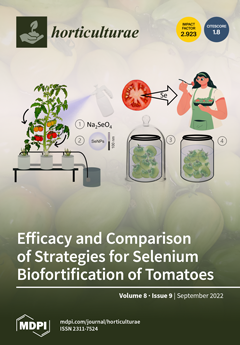The study of the regulatory mechanism of exogenous plant growth regulators (PGRs) on the relevant physiological indicators is essential to maintain the normal growth of
Rosa hybrida under high-temperature conditions. The photosynthetic and physiological characteristics of the ornamental cut rose
Rosa hybrida ‘Carolla’ under high temperature were studied by spraying leaves with various concentrations of exogenous salicylic acid (SA; 0.5, 1.0, 1.5, or 2.0 mmol·L
−1), 6-benzylaminopurine (6-BA; 10, 20, 30, or 50 μmol·L
−1), abscisic acid (ABA; 10, 20, 30, or 50 mg·L
−1), or distilled water (control). The results indicated that a foliar spray of either SA, 6-BA, or ABA could mitigate the impact of high temperatures. Compared to the control, the application of SA, 6-BA, or ABA increased the net CO
2 assimilation rate (A
n), transpiration rate (E), stomatal conductance (G
s), and water use efficiency (WUE) of ‘Carolla’, while decreasing the leaf relative electrical conductivity (REC) and malondialdehyde (MDA) content. The applications of SA, 6-BA, or ABA increased the activities of the antioxidant enzymes superoxide dismutase (SOD), peroxidase (POD), and ascorbate peroxidase (APX) and altered the proline (Pro), soluble protein, and soluble sugar contents. The results showed that foliar sprays of SA, 6-BA, or ABA could enhance the heat tolerance of ‘Carolla’ by promoting photosynthesis, cell membrane structural stability, antioxidant enzyme activity, and osmoregulation in plants under high-temperature stress. The experiment showed that 1.5 mmol·L
−1 SA, 20 μmol·L
−1 6-BA, or 75 μmol·L
−1 ABA could alleviate the damage caused by high temperatures, with 20 μmol·L
−1 6-BA having the best effect.
Full article





